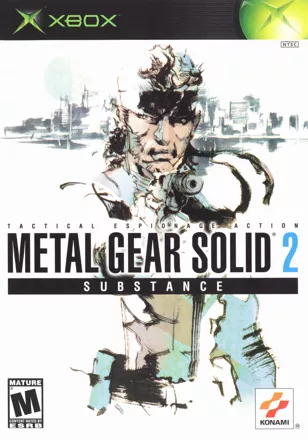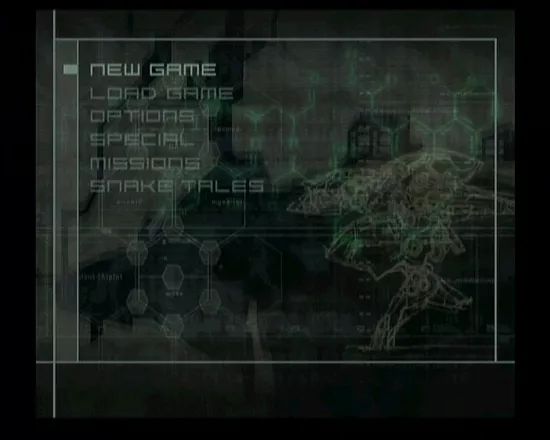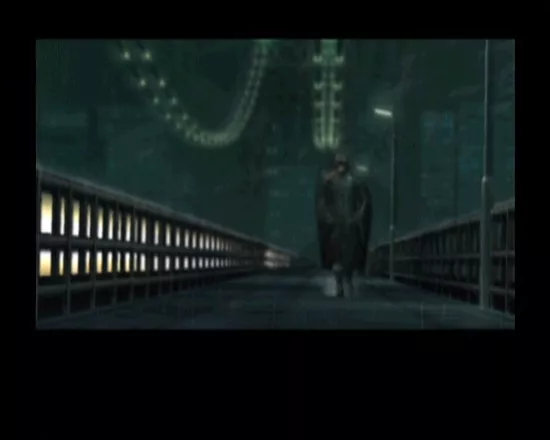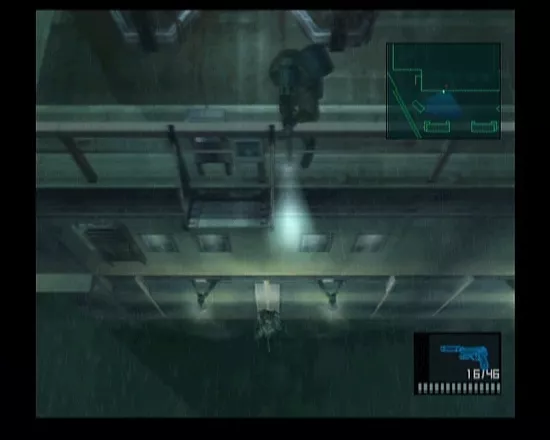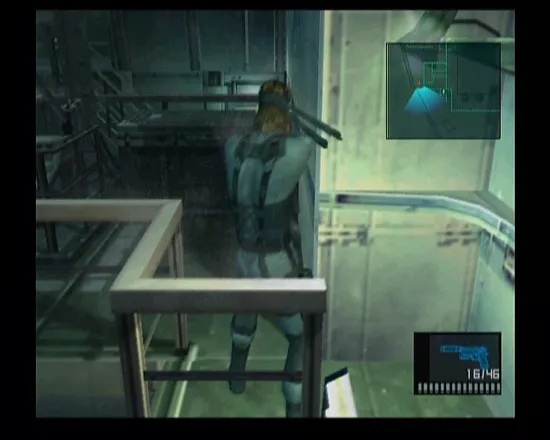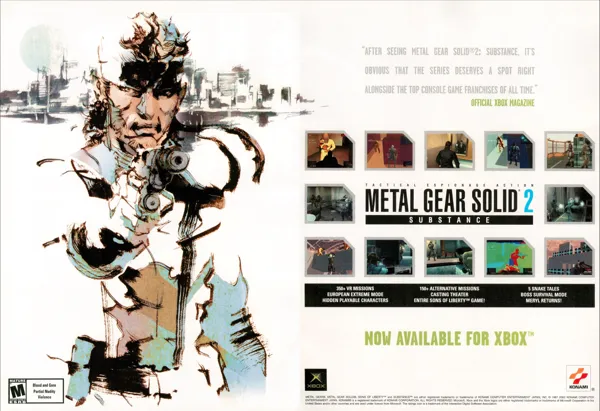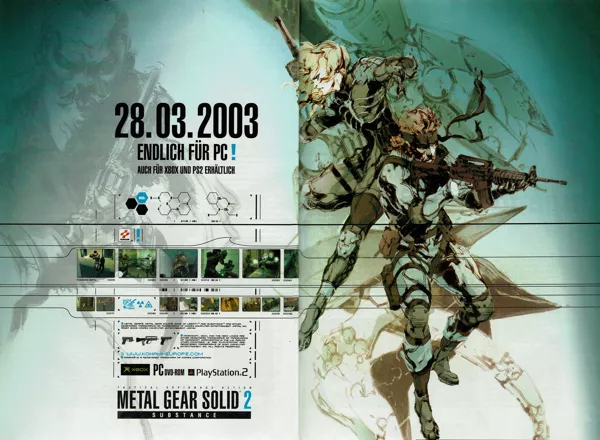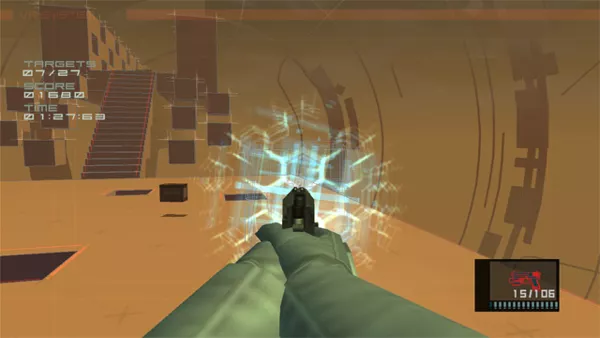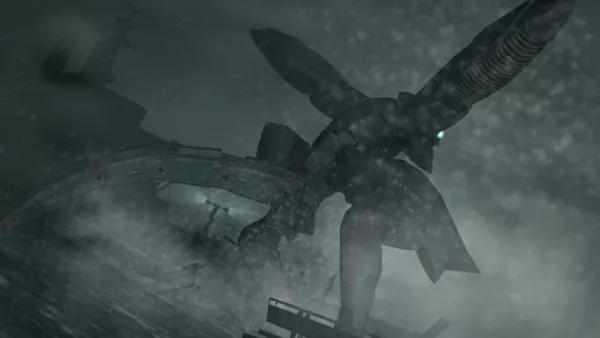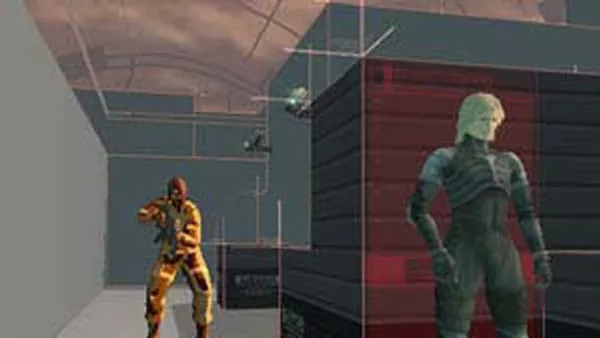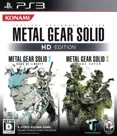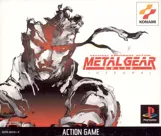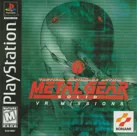Metal Gear Solid 2: Substance
Description official descriptions
Metal Gear Solid 2: Substance is a re-vamped and revised edition of the original Metal Gear Solid 2: Sons of Liberty, in which Solid Snake must recover the stolen Metal Gear Ray from a group of terrorists bent on using its power for unthinkable reasons.
Along with the original espionage shooter comes a collection of 200 virtual reality (VR) missions. Missions range from killing certain targets and using particular weapons, as well as seeing the world of Solid Snake from different perspectives and styles, with first-person target modes and a variety mode including crazy characters of different shapes and sizes.
Also included are various alternative missions, ranging from the protagonist sneaking around and snapping photos of targets to bomb disposal, all out destruction, and more.
Spellings
- 潜龙谍影2真实之影 - Chinese spelling
- 메탈 기어 솔리드 2: 서브스탠스 - Korean spelling
Groups +
Screenshots
Promos
Videos
Add Trailer or Gameplay Video +1 point
See any errors or missing info for this game?
You can submit a correction, contribute trivia, add to a game group, add a related site or alternate title.
Credits (Xbox version)
214 People · View all
| Snake | |
| Jack | |
| Otacon | |
| Rosemary | |
| Olga | |
| Colonel | |
| Solidus | |
| Fortune | |
| Vamp | |
| Fatman | |
| Peter | |
| Emma | |
| Ocelot | |
| Liquid | |
| Sergei | |
| CMC Dolph | |
| Ames | |
| President | |
| Mei Ling | |
| Computer Voice | |
| SEALs | |
| [ full credits ] | |
Reviews
Critics
Average score: 85% (based on 49 ratings)
Players
Average score: 3.7 out of 5 (based on 109 ratings with 4 reviews)
A solid improvement over the original!
The Good
It’s safe to say that Metal Gear Solid 2 was one of the most anticipated games of all time. MGS1 was a runaway hit, and fans were clamoring for its next-gen followup after seeing what Konami was able to produce on the weak PlayStation. The game was a heavy motivator for early PS2 sales. The game was so hotly anticipated, that well over half a year before the game’s release, a demo of MGS2 was bundled along with another Konami game, Zone of the Enders.
MGS2 begins a few years after the original. Solid Snake is sent by Otacaon to infiltrate a tanker leaving New York which may contain a new version of Metal Gear. When that turns out to be the case, the tanker ends up being destroyed with Snake apparently dying in the wreckage. Two years later, a offshore cleanup plant, codenamed the Big Shell, is constructed over the remains of the tanker, and the player is sent in to (of course) infiltrate the facility and stop a terrorist group called Dead Cell. But this mission is not Solid Snake's.
Instead, players got to step into the sneaking suit of a new character, Raiden. Raiden is on his first “real” mission after extensive training using VR , a clear nod to the VR Missions released for the first game. Raiden is almost the exact opposite of Solid Snake. He’s young and (seemingly) inexperienced, but that’s what makes him interesting.In some ways. As cool as Solid Snake was, he was basically an amalgamation of every Hollywood action hero and military soldier. Raiden, in contrast, is genuiniely tense and scared, and desperate to complete the mission so he can see his girlfriend again. and is a much more believable character.
Metal Gear Solid 2 makes many great additions to the gameplay of the original, fleshing it out considerably and making the game that much more fun to play. The player can now hang from railings. This allows the player to drop out of sight if a guard is coming close to them, or they can use this to quickly drop down to lower areas. A dodge move has been added, by pressing the crouch button while moving, the player can jump over gaps and loud floor tiles. New to the series is a tranquilizer gun, which puts enemies to sleep. Using this weapon allows you to play the game with potentially zero kills. Perhaps the biggest addition is a first-person mode, which allows you to shoot your gun and throw objects with pinpoint accuracy. You are going to need this, as head (or groin) shots will instantly incapacitate guards.
To compensate for all of these player advantages, the game’s AI has been smartened up significantly and there are new systems in play. Killing or knocking out a guard does not make their body disappear: you must hide the body, preferably in a locker, so that other guards may not see it. If a guard has not been heard from for a while, additional guards will be sent into the area to investigate. Even when spotted, guards will radio in for reinforcements, which swarm the room and make it darn near impossible to escape. Guards can even spot footprints or trails of your blood left over from an attack, and investigate.
With all of this in place, Metal Gear Solid 2 is a VERY difficult game, far more so than the original. Stealth is king here - levels are much more cramped, so you’ll have to look around corners often and use your weapons to make sure everything is safe. Although the guards still possess the small FOV as seen in the original MGS, the tighter corridors help to mitigate this a lot. In addition guards can also hear and spot you from different vertical heights, making them that much more ruthless. Even crossing the line of sight just out of their field of view is enough to make them suspicious this time around.
Metal Gear Solid 2 is also bigger and longer than the first game. The Tanker alone is almost 75 percent as big as the original Metal Gear Solid, and the Big Shell is 2-3 times its size, despite the fact that you don’t get to visit absolutely every strut. There is a LOT more stealth in this game, with boss fights and setpieces cut back somewhat from the original, (though not entirely). This Makes MGS2 feel like a more substantial game than its predecessor. Konami did the unthinkable with MGS2. They increased both the quantity and the quality of the gameplay.
On top of all of this, Metal Gear Solid 2’s game world and graphics are some of the most convincing I have ever seen. Yes, even in 2015, the game still holds up. Every room is meticulously crafted down to the finest detail, and many things are interactive : shoot a pipe and a burst of steam will explode out of it, shoot a bottle and it explodes, wet shoes leave footprints on the floor. These elements are not just for show: you can use the steam from the pipes to damage enemies, and the footprints can be followed by guards. water makes droplets and streams on the camera. and enemies have realistic rag doll physics, It is kind of amazing how in the push for bigger and bigger game worlds, game developers focused less on the details and more on creating the biggest world possible. But it goes to show that a smaller, more detailed world, can feel more real and immersive than even the largest and most expansive of open ones. As amazing as the upcoming open-world Metal Gear Solid 5 looks, it’s going to have to work very hard to match the quality of MGS2’s world. In some ways, the realistic nature of the game world makes the plot’s themes stand out in much sharper contrast.
Much was made of the fact that Hollywood composer Harry Gregson-Williams, a protege of the legendary Hans Zimmer, would score MGS2. In general the score of MGS2 is more cinema-like in nature as opposed to the gamey score of MGS1: recognizable motifs, such as jazzy saxophone trills, breakbeat electronica, and numerous variations of the MGS theme are used throughout. In general MGS2’s score is not quite as good as MGS1’s, but it’s certainly up there, and the various arrangements of the MGS theme are very memorable.
The Bad
The biggest issue with MGS2 is that parts of it, feel recycled from the original Metal Gear Solid. There’s a section where you have to use a guided missile to hit a circuit breaker which will allow you to pass through a hazardous area. There’s an extended sniping section. A battle with a harrier is nearly the same thing as the battle with the helicopter in the first game. Certain boss battles utilize identical area designs to boss battles in the original. You’ll use Stinger Missiles to battle a Metal Gear once again. You might say that this is laziness, and you’d probably be right. Yet amazingly, but perhaps aggravatingly, the game actually tries to use its narrative to justify all of the reused elements.
The game also has a considerably stranger storyline than the original. Okay, we had a psychic soldier, a cyborg ninja, and clones in the original, but that is nothing compared to what is in MGS2. One of the terrorists is a vampire. A replacement arm for a character from MGS1 who lost his arm is able to somehow possess the person it has been grafted onto. In addition, you also have to also play a section of the game with Raiden completely naked, and yes, you do get to see his bare butt. Thanks a lot Konami, we really needed that (not). And I’m don't even want to mention some of the disgusting stuff with Otacon. Just ugh.
As in the first game, conversations are long and frequent. You can’t take a few steps without someone contacting Raiden on his codec, and more calls must be taken by him than in the original. The final moments of the game in particular are an overstuffed, undercooked mess. There are plot revelations and surprise reveals every minute, and awkward philosophizing about censorship and control that just makes your head hurt trying to process it all. Although Metal Gear Solid 2’s plot is more thematically ambitious and risk-taking than the original, it isn’t quite as satisfying, even though it kept me glued to my controller for long stretches of time. There are so may double crosses and deceptions it is impossible for even the most astute players to keep track of them (on their first time) all and you’re never quite sure what is fact and what is fiction. On top of that you have a challenging stealth action game to get through as well. Even the game itself is a deception: all of the marketing and opening hours made players think that they were going to be playing as Solid Snake, only to have the rug pulled under them hours in when they discovered that Raiden would be taking the lead. As maddening as that is, it’s actually quite brilliant.
The Bottom Line
With all that said, I felt that Metal Gear Solid 2 was an incredible improvement over its predecessor, and I’m really starting to see why so many people love this series. Playing MGS2 was one of the finest gaming experiences I have had in a long time, and I simply could not put it down. Even when I forced myself to stop playing, I always wanted to go back and keep going. And when I’m playing that game nearly 14 years after its original release, it definitely did something right. It's a game that puts many modern AAA epics to shame even though it is also an overstuffed mess with too much to say and too many ways it tries to say it. I can’t say I’ve really played anything like it.
PlayStation 3 · by krisko6 (814) · 2015
The Good
I really enjoyed the original 2D Metal Gear games, but was greatly disappointed with the series’ first outing into the third dimension. While it certainly held moments that were reminiscent of past greatness, Metal Gear Solid was mired in questionable writing and mediocre gameplay. It still held promise, though, featuring memorable characters and striking presentation. Metal Gear Solid 2 was one that I had previously skipped after I was warned by friends that “if I didn’t like the story in the first game, you definitely won’t like the sequel’s.” With this advice still in mind, I went into Solid 2 with slightly lowered, but still optimistic expectations.
Previous games in the series featured largely the same storylines, right down to repeating plot devices. This time around, the story is shaken up in several ways. The series’ main protagonist, Solid Snake is swapped out for new protagonist, Raiden, after a lengthy prologue sequence. Since the last game, Snake has been working with Otacon to destroy or expose black market Metal Gears that have been popping up since the Shadow Moses Incident. After failing a mission and being believed dead (it’s made pretty obvious he isn’t), Raiden takes over in the aftermath just two years after. His job is to infiltrate an offshore environmental clean-up rig called Big Shell, rescue the president, and prevent the launch of a nuclear device. Okay, so maybe it’s not all that much different than the previous games.
A lot has improved in terms of gameplay since the original Solid title. Most notably, the camera is usually pitched at a better angle, so while the view is still incredibly restricting, it’s not as claustrophobic as before. You can also aim and shoot from the first-person perspective, allowing you to better hit enemies that are currently offscreen. I’m still not sure why the camera can’t be controlled at will, since it can in underwater sections, but at least I didn’t find myself frustrated by it like I was in the previous game.
The alarm states are more dynamic. If an enemy spots you, they don’t immediately trigger the alarm; they have to radio it in first. If you take them out before they can finish their call, the alarm won’t go into alert, but guards will be dispatched to investigate. Guards don’t disappear when killed anymore, so if they come across one of their fallen comrades, they’ll begin searching for you. To prevent this, you can now drag bodies to hide stash them away. You can even shoot the radio on a soldier’s belt to prevent him from calling for help. All in all, the combat and stealth is greatly improved this time around, and while the gameplay from the first Solid frustrated me, the improvements here made it much more enjoyable.
The game still features a pretty concerning gameplay to cutscene ratio, but it’s a bit better at actually letting you play the game. Chunks of the game are left undisturbed by the ring of the codec, allowing for memorable sections, like one where you infiltrate a portion of the base dressed as an enemy soldier. When the codec did ring, I found the characters to be a bit more enjoyable to talk to this time around. While Raiden’s girlfriend comes off as attention-starved and creepy, the fact that the game depicts an already ongoing relationship – especially one that is as unhealthy as theirs – is actually pretty rare for video games. Snake in his supporting role also shows a different side of the character, and it’s pretty well done.
Most strikingly, the Metal Gear series has a history of breaking the fourth wall, and this finally pays off in Metal Gear Solid 2’s conclusion where the whole narrative jumps off the deep end in an effort to play with your expectations. Without spoiling anything, the climax of the game is well worth sticking through all the feverish exposition about conspiracies. It’s a moment where the game seems to acknowledge that everything about it is absolutely ludicrous and fully owns up to it. Though, unfortunately it does once again feature an almost intolerably horrible denouement.
The Bad
Yet despite the ambitious narrative, the Metal Gear Solid 2’s story still mired in the same overblown exposition and questionable dialogue. While the cutscenes and codec sequences are spaced apart a little better to provide a more reasonable pace with less starting and stopping, most of the cutscenes are significantly longer than the ones found in the original Solid title. Perhaps the good news is that the added length is mainly devoted to action rather than entirely filled with long death monologues, random spillages of melodramatic life stories, and lengthy dialogues about the nature of life. Those are still present, but the story attempts to be more than just heavy-handed character development, at least.
The biggest issue is that the narrative, even more than it was in the first Solid, is extremely unfocused. The writers seem to have a lot to say about free-will, censorship, love, life, war, nuclear proliferation, and even reality itself, so all of it gets thrown into the same pot, disguised under a story about rescuing the president. It constantly harps on the old conspiracy about a shadow organization that controls the government, which is a tale as old as time. The result is a complete mess, where characters complain about their petty issues while the fate of the world hangs in the balance. At the worst of times, character motivation becomes muddy and incomprehensible, and at the best of time it scrapes out something insightful, and then quickly buries it so it can throw something else your way.
That’s the worst of it, though. In terms of gameplay, I didn’t find much that irritated or annoyed me. The only part that bothered me was the boss battles. They’re much fewer in number and pretty weak (par for the series, it seems). Yet what was really disappointing wasn’t the bosses you fight, but the ones you don’t. On a few occasion, a fight with a big named baddie is brought up, then resolved in a cutscene. It’s weird; the game seems unwilling to let the player take part in these action sequences, afraid that the fight won’t be bombastic enough.
The Bottom Line
With greatly improved gameplay, I certainly enjoyed Metal Gear Solid 2 a lot more than the first Solid title. The variety in gameplay, the improved stealth mechanics, and the greater attention to interactivity makes it a joy to play. Even the story, though still riddled with drawn out moments of dry exposition, has a few moments of brilliance that shine through and make it a more enjoyable narrative to sit through. However, its storytelling still seems to be at odds with the gameplay – perhaps more so than before. I’m not sure how I feel about sitting through 20 minute cutscenes in the first place, but when situations that should be part of the gameplay are resolved within them, I feel like the developers have misplaced their priorities. Nonetheless, Metal Gear Solid 2 is a GOOD game, and I’m glad to have the series back to some sort of shape that I can enjoy.
PlayStation 3 · by Adzuken (836) · 2015
An Amazing (Cinematic?) Experience
The Good
True to the previous titles in the series, Substance continues the tactical espionage experience and does it well. Gameplay is quite similar to the first Solid, as is the gameplay overhead gameplay perspective. The ability to switch to a first-person perspective was a welcome addition, perfect for peeking around a corner or discovering a hidden item. Graphically, the game is stunning, even compared to most PS2 games of the early 2000s. The terrain is beautifully and masterfully rendered, as are the characters in the games myriad of cutscenes. Sounds are crisp and clear; from the buffeting of a torrential downpour to the calling of seagulls, they all add to the ambiance and depth of the environment. The musical score is phenomenal as it is in all of Kojima's titles; each track meshes with your current in-game situation perfectly. In addition to the main campaign, there are many challenges, alternative missions (Snake Tales), and unlockables that undoubtedly increase replay value.
The Bad
Honestly, Konami got almost everything right with Substance. The only two complaints I can muster are these:
-
The number of cut scenes and radio conversations in the game makes it feel like you're viewing a film. While it isn't annoying (rather, they are essential to the understanding of the message behind the game and are the setting for several humorous encounters), I believe the story could still have been conveyed well with fewer cut scenes.
-
There were times when I would stand right behind an enemy guard and be astonished that this unsuspecting adversary would not hear me. However this occurred rarely, and for the most part A.I. is well-responsive and intelligent.
The Bottom Line
It doesn't take long for games both casual and hardcore to be hooked on Metal Gear Solid 2: Substance and be satisfied (as well as puzzled sometimes) by its gameplay, immersed in the depth of its plot, and connected to the emotions of its characters. If you are looking for a game that will give you hours of enjoyment and tons of replay value, buy MGS 2: Substance.
PlayStation 2 · by Nick Slavin (9) · 2009
Trivia
Title
Hideo Kojima was partially inspired to call this version of Metal Gear Solid 2 "Substance" by 70's British band Joy Division's greatest hits compilation CD entitled Substance 1977-1980.
Windows version
- As of 2003, Metal Gear Solid 2: Substance had the biggest installation size for a PC game at 7.17 GB.
- The PC version is direct port of the Xbox version with no modifications. Even the tutorial refers to the Xbox controllers.
Information also contributed by Stillman.
Analytics
Related Sites +
-
JUNKER HQ
This fansite is dedicated to the games produced and/or designed by Hideo Kojima and contains all kinds of trivia, artwork, plot summaries, discussion forums and more. -
Konami: Substance
The official website. -
Metal Gear Solid: The Unofficial Site
A fansite that contains information about the whole Metal Gear franchise, including galleries, interviews, downloadable content and discussion boards.
Identifiers +
Contribute
Are you familiar with this game? Help document and preserve this entry in video game history! If your contribution is approved, you will earn points and be credited as a contributor.
Contributors to this Entry
Game added by Kartanym.
Windows, PlayStation 2 added by Corn Popper. Android added by GTramp. PS Vita, PlayStation 3 added by MAT.
Additional contributors: MAT, Apogee IV, John Chaser, —-, Patrick Bregger, Plok, Rik Hideto, li zhen.
Game added November 9, 2002. Last modified April 10, 2025.


